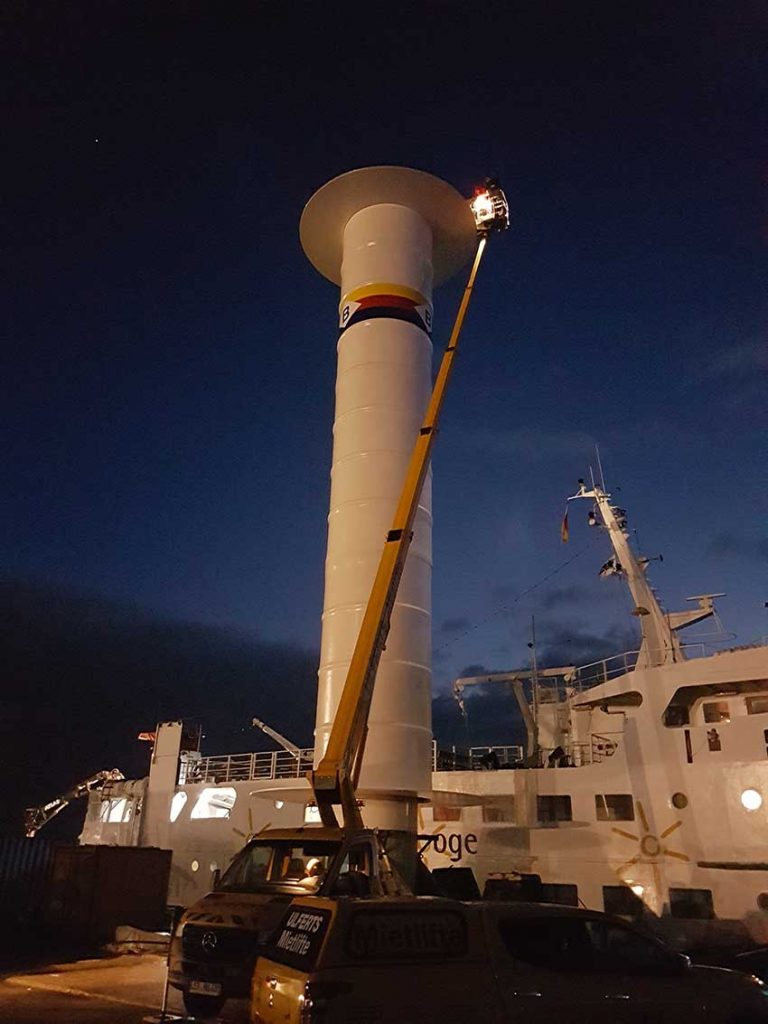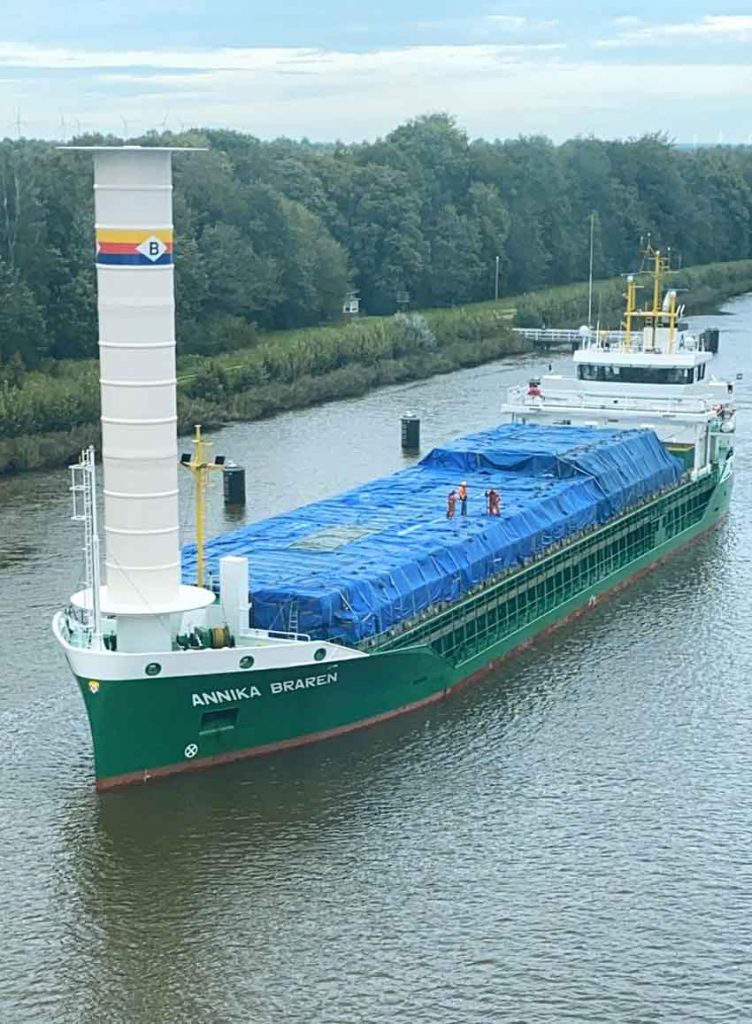Development, manufacturing and maintenance of Flettner rotors in the maritime industry are the competencies of Eco Flettner GmbH. As one of the pioneers in Wind Assisted Ship Propulsion (WASP), Eco Flettner developed high-efficient rotors for retrofits or new buildings in the merchant fleet.
The Eco Flettner GmbH has been founded by partners of the German-Dutch INTERREG 4 A project Maritim, subproject „Wind Hybrid Coaster“ and „Wind Ship- Engineering and Design“.
The company is based in northern Germany, but the rotors could be built in shipyards or ports around the world. The product portfolio offers high-performance rotors with two end disks, which reduces significantly fuel consumption and emissions.
Two vessels are equipped with Eco flettner rotors, MV Fehn Pollux (2018) and MV Annika Baren (2021).
The rotor technology can be used on a variety of ship types and is particularly suitable for cargo ships. Due to the sail area design, which is up to ten times smaller than profile sails of other sailing systems, high sailing performance can be brought onto the ships. The maintenance-free use and the fully automatic regulation and control make it easy for the crew to use this technology.
Easy Engineering: What are the main areas of activity of the company?
FLETTNER: Renewable energy growth is accelerating faster than ever worldwide and Eco Flettner is actively driving this energy transition. Our goal is to make propulsion thrust by wind energy as cheap as possible and thus globally competitive. Eco Flettner develops rotors whose operating and service concepts are designed to keep emission and costs as low as possible in the lifetime on board of cargo vessels.
Eco Flettner rotors have already a very short ROI time.
Eco Flettner offers rotor sailing systems worldwide for new buildings or retrofits on existing ships.

E.E: What’s the news about new products?
FLETTNER: Together with MARIKO the maritime competence center from Leer/Germany and other project partners we have got aprovment of a BMWK (PTJ Jülich)/Germany funding project FlettnerFLEET in total about 7 million Euro. The contents of these project are to optimize Eco Flettner rotor technology, designing of end disks or forms and surfaces of the cylinders and implementation of rotor sailing systems on board of different ship types in concept. FlettnerFLEET will running over a time period of three years.
Project outline:
- Flettner Fleet – Development of a scientifical and technological basis to prepare the market penetration of Flettner rotors on various ship types as a contribution to low-emission shipping.
The project partners:
- abh Ingenieur-Technik GmbH, Emden/Germany
- Bureau Veritas Holding GmbH, Hamburg/Germany
- Dirks Elektrotechnik GmbH, Moormerland/Germany
- Eco Flettner GmbH, Leer/Germany
- Enercon Logistic GmbH, Aurich/Germany
- Fehn Ship Management GmbH & Co. KG, Leer/Germany
- , Hamburg/Germany
- HB Hunte Engineering GmbH, Oldenburg/Germany
- Hochschule Emden/Leer, Leer/Germany
- IBK-fibertec GmbH, Büren/Germany
- ISSIMS GmbH, Warnemünde/Germany
- Krey Schiffahrts GmbH & Co. KG, Leer/Germany
- NSB Niederelbe Schiffahrtsgesellschaft mbH & Co. KG, Buxtehude/Germany
- Rörd Braren Bereederung, Kolmar a. d. Elbe/Germany
- Schottel GmbH, Wismar/Germany
- Winterthur Gas & Diesel Ltd., Winterthur/Swizerland

E.E: What are the ranges of products?
FLETTNER: The focus is on standard rotor sizes with diameters of 3 m, 4 m and 5 m but with variable heights, up to wind propulsion performances of more than 2,500 kW.
For Eco Flettner rotors validated sail performance data from the University of Applied Sciences Emden-Leer/Germany for the Eco Flettner Rotor sailing systems are available.
The savings potential for Eco Flettner rotors with two end disks depends on the wind conditions along routes and other factors. Under medium-to-good-and -to- very good wind conditions, an annual average of approximately 2 kW and up to >3 kW main engine equivalent power can be saved per 1m² of projected rotor area (for guidance). Precise predictions have to be made by route simulations for a specific vessel.
The standard diameter can be adjusted individually in height. Number and dimensions of rotor sailing systems have to be matched to the desired demands of propulsion thrust, suitable places on deck and the function of the vessel. Also, the end disks will be manufactured on structural conditions and demands on different ship types and sizes.
Engineering, electrical components, cabling, mounting of the rotor on board, monitoring and automatic control system, weather routing system and management comes from Eco Flettner.

E.E: At what stage is the market where you are currently active?
FLETTNER: Unfortunately, there is still no legal regulation to avoid CO2 in shipping. EU-ETS will come in operation at earliest in 2024. It will be the first important step concerning climate protection initiated by the EU. Unfortunately, the IMO is still delaying its own rules, which are needed worldwide. This has to be changed as soon as possible if the maritime industry wants to make a contribution reducing emissions because humanity has no more time to lose.
The merchant fleet is responsible for the emission of about one billion tons of carbon dioxide, which corresponds to 3 percent of the total man-made CO2 emissions. It also causes around 15 percent of global nitrogen oxide emissions and 13 percent of sulfur dioxide emissions, and the trend is rising. However, I would like to point out that these figures do not include the ships under 5000 GT. The actual emissions are really significantly higher.
Flettner rotors can already contribute to a significant reduction in fuel combustion. The technology is proven and available in the market. ROI times are very short, with subsidies less than 4 years.

